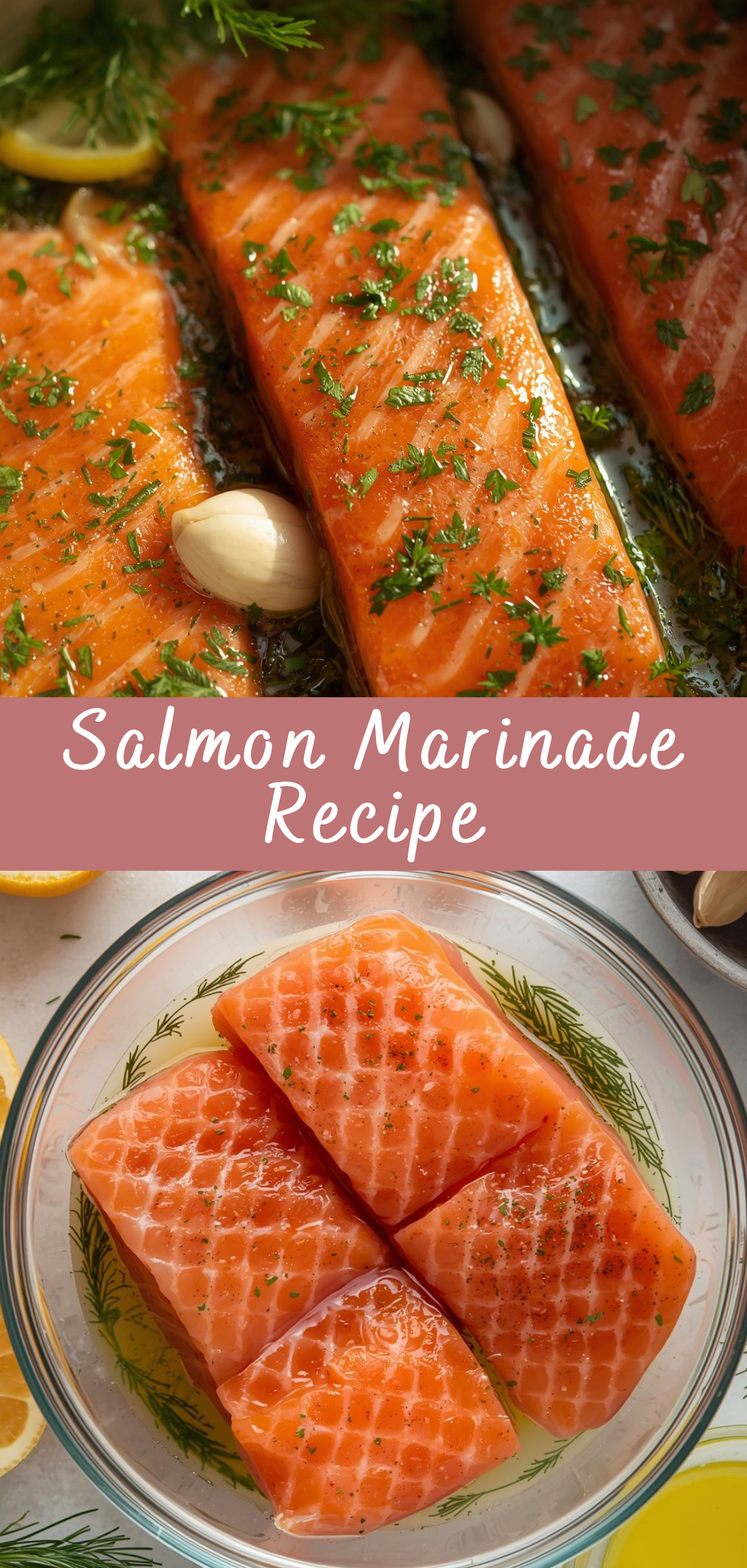The Ultimate Salmon Marinade Recipe: Unlocking Flavor, Texture, and Culinary Creativity
Few ingredients strike the delicate balance between nutrition and indulgence quite like salmon. Rich in omega-3 fatty acids, packed with protein, and luxuriously tender when cooked right, salmon has become a staple in kitchens across the globe—from weeknight family dinners to upscale restaurant menus. Yet, while salmon’s natural flavor is impressive on its own, it truly reaches its full potential when enhanced by the right marinade.

A well-crafted marinade doesn’t just add flavor. It transforms. It tenderizes, penetrates, and enhances the salmon’s already buttery texture, delivering layers of complexity and richness that elevate the dish from simple to extraordinary. Whether you’re preparing fillets for grilling, pan-searing, baking, or broiling, the right marinade acts as both a flavor booster and a moisture protector, ensuring that your salmon remains succulent and satisfying every time.
But what makes a great salmon marinade?
It’s not just about mixing a few sauces and hoping for the best. It’s about understanding the interaction between acid, fat, herbs, aromatics, and sweeteners. It’s about balancing flavor profiles—savory, sweet, spicy, umami—and considering how each ingredient impacts the cooking method and final result. It’s about matching the marinade to the occasion: Do you want something bold and smoky for the grill? Or something bright and citrusy for a summer salad? Maybe something rich and sweet for a cold-weather dish?
In this comprehensive guide, we’ll dive deep into everything you need to know about marinating salmon—from foundational principles to advanced techniques. We’ll explore ingredient choices, marinade timing, regional and cultural variations, and even science-backed tips to avoid common pitfalls (like over-marinating or choosing the wrong acid).
By the end of this article, you won’t just have one go-to salmon marinade recipe—you’ll have the knowledge and confidence to create your own, customized to your taste preferences, cooking method, and dietary needs. We’ll also share multiple marinade recipes (classic, Asian-inspired, Mediterranean, spicy, sweet, and more), each with tips on preparation, storage, and best pairings.
Whether you’re a seasoned home cook or just learning your way around the kitchen, this guide will equip you with everything you need to turn a simple piece of salmon into something truly unforgettable.
Let’s begin with the basics—and work our way to mastery.
Section 1: Understanding Marinades – The Science and Purpose
Before we start mixing ingredients, it’s important to understand what a marinade actually does—and what it doesn’t do. This knowledge helps you make better choices in both flavor and technique.
1.1 What Is a Marinade?
A marinade is a seasoned liquid used to soak foods—usually meats, fish, or vegetables—before cooking. Its primary purposes are:
-
Flavor Infusion: Herbs, spices, acids, and aromatics penetrate the surface of the salmon, giving it deeper taste.
-
Moisture Retention: Marinades with oils and natural sugars help the fish stay moist during cooking.
-
Textural Tenderizing: Acids like vinegar, citrus, or yogurt can gently break down the outer protein structure, making salmon feel even softer and more luxurious in the mouth.
1.2 Do Marinades Penetrate Deeply?
Contrary to popular belief, marinades don’t usually penetrate more than a few millimeters into most proteins—especially dense ones. But with salmon’s softer texture, flavor can reach slightly deeper, especially in thinner cuts or with longer resting times.
1.3 How Long Should You Marinate Salmon?
Time matters—a lot.
-
15–30 minutes: Light flavor infusion; good for thin fillets.
-
30–60 minutes: Ideal for most salmon pieces; flavors are present but not overpowering.
-
2+ hours: Stronger flavor, but be cautious—acidic marinades can begin to “cook” the fish (like ceviche), resulting in a mushy texture.
Important Note:
Never marinate salmon for more than 24 hours. In fact, most recipes should max out at 1–2 hours unless you’re using a low-acid marinade.
Section 2: Core Components of a Salmon Marinade
Every great salmon marinade uses a balance of five basic elements. Here’s what each component does and how to use it wisely:
2.1 Acid – For Brightness and Tenderizing
-
Examples: Lemon juice, lime juice, vinegar (rice, apple cider, balsamic), white wine, yogurt
-
Purpose: Breaks down surface proteins, adds tang, balances richness
-
Caution: Too much acid, or marinating too long, can turn salmon mushy
2.2 Fat – For Moisture and Flavor Carrying
-
Examples: Olive oil, sesame oil, avocado oil, neutral vegetable oils
-
Purpose: Helps retain moisture and distributes fat-soluble flavors (like herbs and spices)
2.3 Salt or Umami Agent – For Deep Flavor
-
Examples: Soy sauce, tamari, miso, sea salt, fish sauce, Worcestershire, anchovy paste
-
Purpose: Enhances taste at a molecular level and creates a satisfying savory profile
2.4 Sweetener – For Balance and Caramelization
-
Examples: Honey, brown sugar, maple syrup, agave, molasses
-
Purpose: Balances acidity and bitterness; helps with browning when grilling or searing
2.5 Aromatics and Herbs – For Complexity
-
Examples: Garlic, ginger, shallots, dill, parsley, rosemary, chili flakes, mustard, citrus zest
-
Purpose: Adds high and mid-notes of flavor that define the marinade’s personality
Section 3: Step-by-Step Instructions – Crafting the Perfect Marinade
Let’s now walk through the process of making a balanced, flavorful salmon marinade and applying it effectively.
3.1 Step 1 – Select Your Salmon
Choose fresh, high-quality salmon—wild-caught if possible.
-
Fillets: Skin-on or skinless, 1–1.5 inches thick
-
Steaks: Thicker cuts; great for grilling
-
Portions: Individual cuts ideal for marinating evenly
Tip: Always check for pin bones and remove them before marinating.
3.2 Step 2 – Mix the Marinade (Base Recipe)
Here’s a balanced all-purpose salmon marinade recipe you can build from:
Ingredients:
-
3 tablespoons olive oil (fat)
-
2 tablespoons soy sauce (salt/umami)
-
2 tablespoons lemon juice (acid)
-
1 tablespoon honey or maple syrup (sweet)
-
2 garlic cloves, minced (aromatic)
-
1 teaspoon Dijon mustard (emulsifier & flavor)
-
Fresh ground black pepper to taste
-
Optional: 1 teaspoon fresh dill or thyme
Instructions:
-
Combine all ingredients in a bowl or jar.
-
Whisk well until emulsified (thick and combined).
-
Taste. Adjust as needed (more acid, more sweetness, etc.).
-
Use immediately, or refrigerate for up to 3 days.
3.3 Step 3 – Prepare the Salmon
-
Pat the salmon dry with paper towels.
-
This helps the marinade cling better and improves cooking texture.
-
-
Place salmon in a shallow dish or a zip-top bag.
-
Pour marinade over the fish, making sure it’s coated on all sides.
-
Cover and refrigerate.
Marination Time:
-
Thin fillets: 20–30 minutes
-
Thicker cuts: Up to 1 hour
3.4 Step 4 – Choose Your Cooking Method
Once marinated, remove the salmon from the marinade and let excess drip off. Do not reuse raw marinade unless you boil it for several minutes.
Choose a cooking method that suits your preference:
Grilling:
-
Preheat grill to medium-high heat
-
Oil grates to prevent sticking
-
Grill salmon 3–5 minutes per side, depending on thickness
Pan-Searing:
-
Heat a tablespoon of oil in a nonstick or cast iron skillet
-
Place salmon skin-side down first
-
Cook over medium heat 4–5 minutes per side
Baking:
-
Preheat oven to 375°F (190°C)
-
Line a baking dish with parchment or foil
-
Bake salmon for 12–15 minutes, or until flakes easily
Broiling:
-
Set oven to high broil
-
Place salmon on foil-lined sheet pan
-
Broil for 5–7 minutes, watching closely to avoid burning
3.5 Step 5 – Finishing Touches
After cooking:
-
Rest the salmon for 2–3 minutes
-
Garnish with fresh herbs, lemon zest, or a final drizzle of reserved (cooked or fresh) marinade
-
Serve with sides: rice, quinoa, roasted vegetables, or salad
3.6 Optional: Make a Glaze or Sauce from Marinade
If you want extra flavor:
-
Pour leftover marinade into a saucepan
-
Bring to a boil, then reduce heat and simmer for 5–7 minutes until slightly thickened
-
Use it as a glaze or drizzle
Salmon Marinade Recipe
Few ingredients strike the delicate balance between nutrition and indulgence quite like salmon. Rich in omega-3 fatty acids, packed with protein, and luxuriously tender when cooked right, salmon has become a staple in kitchens across the globe—from weeknight family dinners to upscale restaurant menus. Yet, while salmon’s natural flavor is impressive on its own, it truly reaches its full potential when enhanced by the right marinade.
Ingredients
- 1/4 cup olive oil
- 2 tablespoons soy sauce (low sodium recommended)
- 1 tablespoon honey (or maple syrup for a refined sugar-free version)
- 1 tablespoon lemon juice (or lime juice)
- 2 cloves garlic, minced
- 1 teaspoon Dijon mustard (optional but adds depth)
- 1/2 teaspoon black pepper
- 1/2 teaspoon dried dill or 1 tablespoon fresh dill (optional)
Instructions
- Make the marinade:
In a small bowl or measuring cup, whisk together all ingredients until well combined. - Marinate the salmon:
Place salmon fillets in a shallow dish or a zip-top bag. Pour the marinade over the salmon, ensuring it coats all sides.
Cover and refrigerate for 15–30 minutes (no more than 1 hour, or the acid can start to break down the fish). - Cook the salmon:
Remove from marinade and cook salmon as desired:
Grill: 4–6 minutes per side
Bake: 400°F (200°C) for 12–15 minutes
Pan-Sear: 4–5 minutes per side on medium-high heat - Serve:
Serve hot with your favorite sides like rice, roasted veggies, or a fresh salad.
Notes
- Don’t over-marinate: Acidic ingredients (like lemon juice) can make the salmon mushy if left too long.
- Add spice: Include a pinch of red pepper flakes or a dash of sriracha for heat.
- For extra flavor: Reserve a spoonful of marinade before adding to raw salmon to drizzle over the cooked fish.
- No soy? Use coconut aminos or tamari for a gluten-free version.



